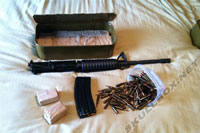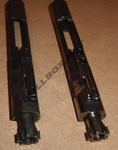
AR-15 Upgrades: Uppers and Bolt Carrier Groups (BCG)
By Erik Rodriguez
Tags: free floating rail, heat sheilds, hand guard, vertical grip, ACS stock, AR-15 stock replacement, magpul stock
This article provides information about common upgrades for the AR-15. Detailed links to more specific information is included for some of the listed options. You can find other links for the AR-15 by clicking here.
Introduction
I am not a gunsmith, expert, or anything close. I am sure there are many people with more expertise than I, but here is what I know about the AR-15. I also have some content posted about the GSG-5. I welcome all comments and please correct me if anything I have here is not accurate.
Upgrades
The following sections explain different upgrades associated with the AR-15 platform. Some of these are very simple "drop-in" upgrades. Others are fairly complex and require some time and knowledge of the weapon. Be careful when disassembling your weapon. ALWAYS MAKE SURE THE WEAPON IS ULOADED. I caught myself with a live round in the chamber because I picked up a loaded magazine that was sitting next to a stack of unloaded ones. YOU CAN NEVER BE TOO SAFE!
AR-15 uppers
Since the AR-15 is a "modular" weapon, it can be retrofitted with different options. It is also possible to get different "uppers" (upper being the upper receiver, BCG, and barrel) and attaching them to your lower. These uppers are usually different calibers or SBR (short barrel rifles) meaning they are less than 16" in length. Popular uppers include calibers such as 9mm, 6.8 SPC, 5.45x39, 6.5 Grendel, and .50 Beowulf. Most of the ammo for these uppers is more expensive than the standard 5.56/.223 with the exception of the .22 LR, 9mm, and 5.45x39. The 5.45x39 ammo is made in Russia and is corrosive, meaning it will rust your rifle. Some 5.45x39 uppers (like Spike's tactical) have special metal compounds to protect against corrosion. The 5.45x39 is balistically (if that's even a word) close to the 5.56. The images below show various uppers with different barrel lengths and calibers.

Click to Enlarge
An Adam Arms 11.5" upper with a piston system and free floating rail

Click to Enlarge
Noveske 10.5" upper with free float rail and broomstick
|
|

Click to Enlarge
Olympic Arms 16" 9mm upper with magazine

Click to Enlarge
Smith & Wesson 5.45x39 16" upper
|
|

Click to Enlarge
6.8 SPC with 20" barrel

Click to Enlarge
Rock River 6.5 Grendel with 18" barrel
|
|

Click to Enlarge
DPMS .308 upper with 16" barrel
|
|
Bolt carrier group (BCG)
The bolt carrier group includes the actual bolt and housing the surrounds it. The two major upgrades for this are fairly simple to understand. The first is a chrome or chrome plated BCG (both the outer housing and internal bolt), and the second is a nickel boron coated BCG. They are both fairly expensive upgrades. The chrome model with set you back around $175 and the NiB is even more at around $225. Both are easier to clean, but the NiB has a special coating that makes the BCG slide much easier inside the receiver with little to no lubrication. Using a NiB BCG will improve performance by allowing the weapon to fire more rounds without requiring a cleaning. Upon replacing mine with a NiB BCG, the charging handle was noticably easier to operate. I am also able to shoot steel cased ammo without any problems. There are also upper receivers and charging handles coated with NiB for a more complete no-lube setup. The image below shows the difference between a standard BCG, and one coated with Nickel Boron.

Click to Enlarge
Nickel Boron vs. Standard Bolt Carrier Group

Click to Enlarge
Nickel Boron vs. Standard BCG
|
|
More AR-15 related content:
Ammunition: .223 vs. 5.56
AR-15 Upgrades: Choosing an optic
AR-15 Upgrades: Stock, Hand Guard, and Vertical Grip
AR-15 Upgrades: Uppers and Bolt Carrier Groups (BCG)
AR-15 Upgrades: Sights, Ejector Door, and Pins
AR-15 Upgrades: Triggers, Breaks, Supressors, Sling Adapter
Contact Us
NOTE: this form DOES NOT e-mail this article, it sends feedback to the author.
|
|
